Security Protocols in Fog and Mobile Edge Computing - ITC571
VerifiedAdded on 2021/04/17
|15
|3446
|200
Annotated Bibliography
AI Summary
This annotated bibliography, prepared for ITC571 at Charles Sturt University, examines the security protocols in fog and mobile edge computing. The assignment analyzes several research papers, including works by Roman et al., Dastjerdi et al., Chiang & Zhang, Luan et al., Stojmenovic et al., Yi et al., Mao et al., and Alrawais et al. These papers discuss security threats, architectural considerations, and application scenarios within fog and mobile edge computing environments. The annotations highlight the strengths and limitations of each study, focusing on issues such as the lack of detailed security protocols, insufficient research methodologies, and the need for comprehensive security recommendations. The bibliography covers a range of topics, from the application of fog computing in IoT devices to the challenges of implementing 5G technology, emphasizing the need for robust security measures to protect user data and ensure the reliability of these emerging technologies. Overall, the assignment underscores the critical importance of addressing security vulnerabilities in the development and deployment of fog and mobile edge computing systems.
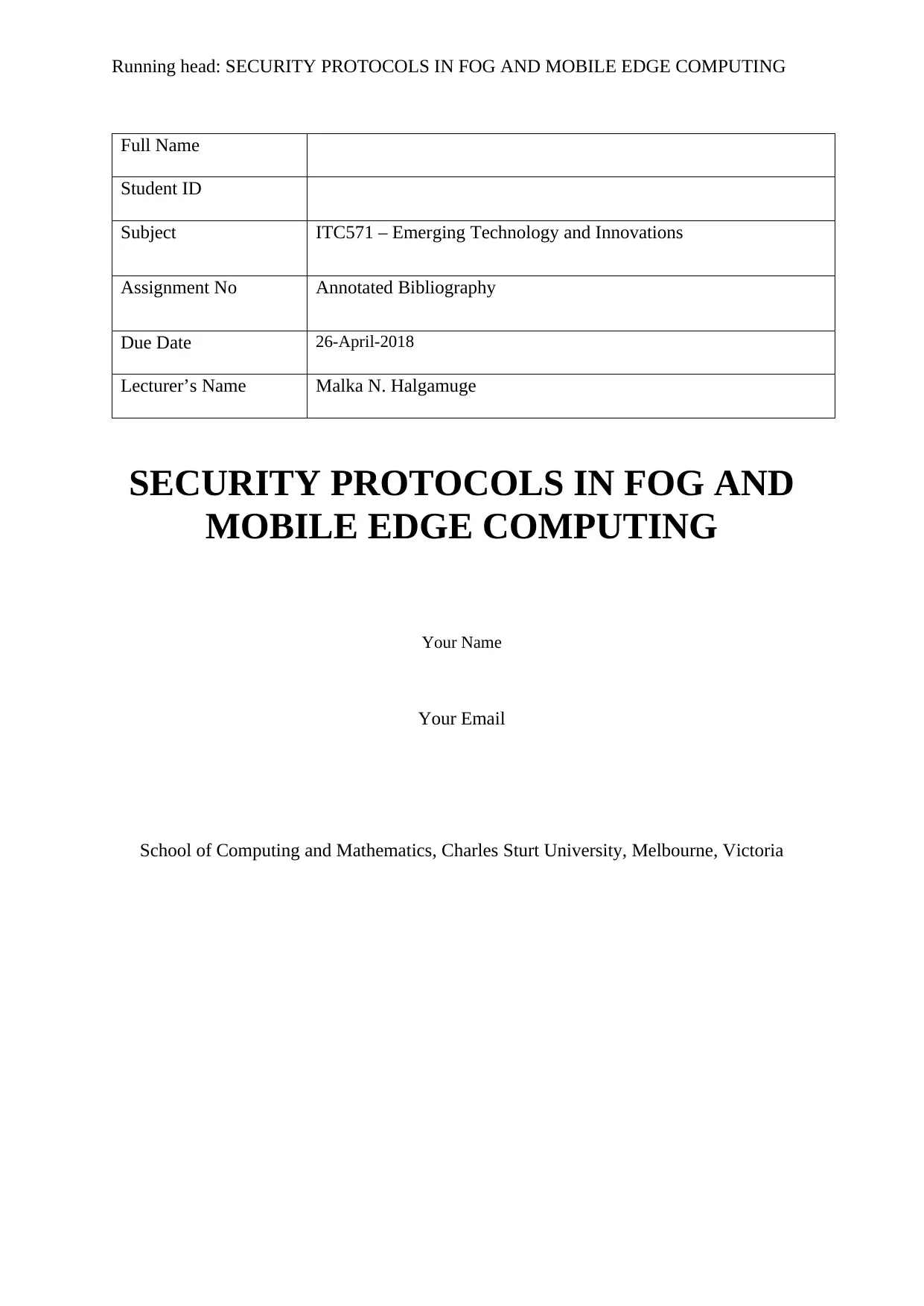
Running head: SECURITY PROTOCOLS IN FOG AND MOBILE EDGE COMPUTING
Full Name
Student ID
Subject ITC571 – Emerging Technology and Innovations
Assignment No Annotated Bibliography
Due Date 26-April-2018
Lecturer’s Name Malka N. Halgamuge
SECURITY PROTOCOLS IN FOG AND
MOBILE EDGE COMPUTING
Your Name
Your Email
School of Computing and Mathematics, Charles Sturt University, Melbourne, Victoria
Full Name
Student ID
Subject ITC571 – Emerging Technology and Innovations
Assignment No Annotated Bibliography
Due Date 26-April-2018
Lecturer’s Name Malka N. Halgamuge
SECURITY PROTOCOLS IN FOG AND
MOBILE EDGE COMPUTING
Your Name
Your Email
School of Computing and Mathematics, Charles Sturt University, Melbourne, Victoria
Paraphrase This Document
Need a fresh take? Get an instant paraphrase of this document with our AI Paraphraser
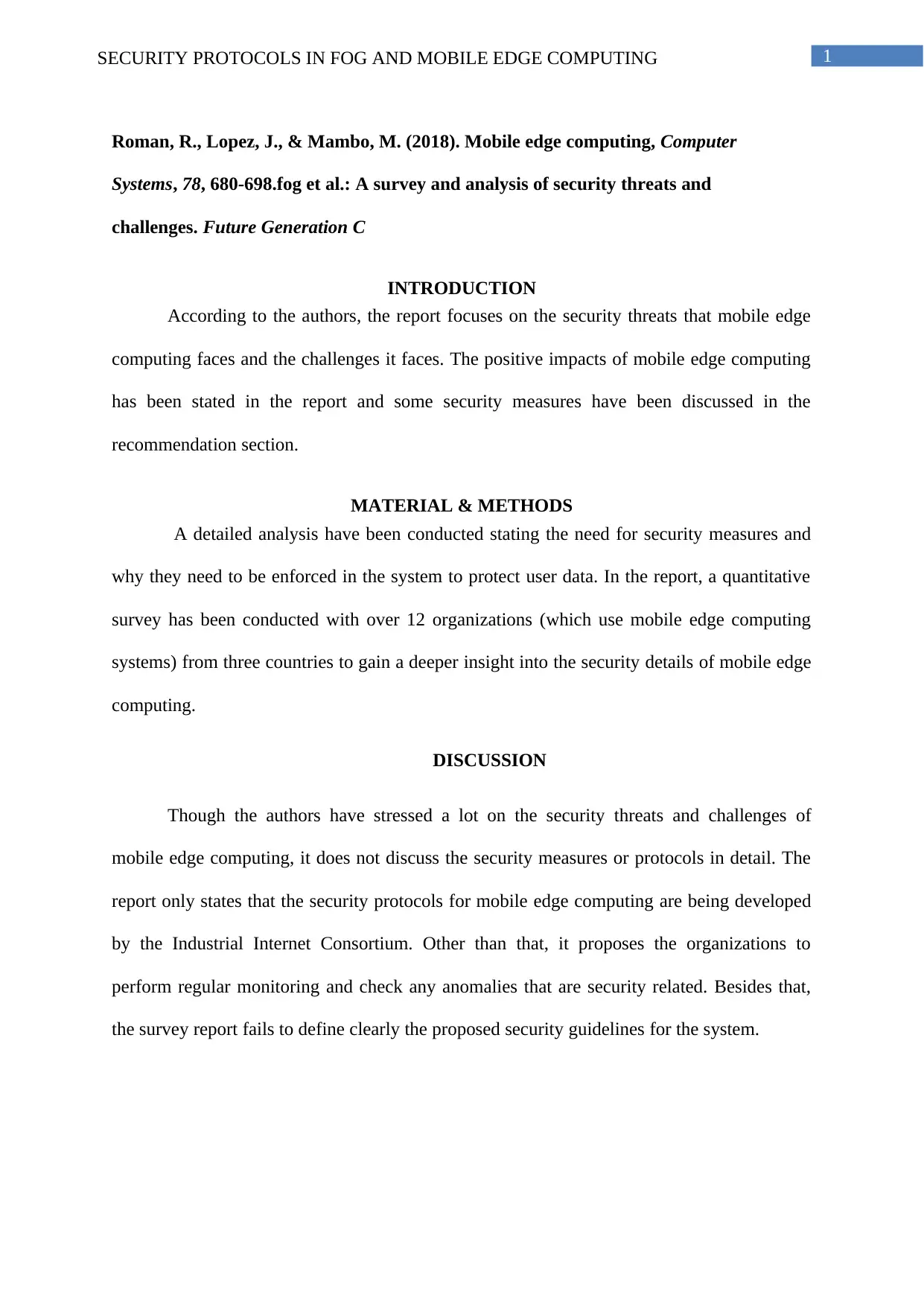
1SECURITY PROTOCOLS IN FOG AND MOBILE EDGE COMPUTING
Roman, R., Lopez, J., & Mambo, M. (2018). Mobile edge computing, Computer
Systems, 78, 680-698.fog et al.: A survey and analysis of security threats and
challenges. Future Generation C
INTRODUCTION
According to the authors, the report focuses on the security threats that mobile edge
computing faces and the challenges it faces. The positive impacts of mobile edge computing
has been stated in the report and some security measures have been discussed in the
recommendation section.
MATERIAL & METHODS
A detailed analysis have been conducted stating the need for security measures and
why they need to be enforced in the system to protect user data. In the report, a quantitative
survey has been conducted with over 12 organizations (which use mobile edge computing
systems) from three countries to gain a deeper insight into the security details of mobile edge
computing.
DISCUSSION
Though the authors have stressed a lot on the security threats and challenges of
mobile edge computing, it does not discuss the security measures or protocols in detail. The
report only states that the security protocols for mobile edge computing are being developed
by the Industrial Internet Consortium. Other than that, it proposes the organizations to
perform regular monitoring and check any anomalies that are security related. Besides that,
the survey report fails to define clearly the proposed security guidelines for the system.
Roman, R., Lopez, J., & Mambo, M. (2018). Mobile edge computing, Computer
Systems, 78, 680-698.fog et al.: A survey and analysis of security threats and
challenges. Future Generation C
INTRODUCTION
According to the authors, the report focuses on the security threats that mobile edge
computing faces and the challenges it faces. The positive impacts of mobile edge computing
has been stated in the report and some security measures have been discussed in the
recommendation section.
MATERIAL & METHODS
A detailed analysis have been conducted stating the need for security measures and
why they need to be enforced in the system to protect user data. In the report, a quantitative
survey has been conducted with over 12 organizations (which use mobile edge computing
systems) from three countries to gain a deeper insight into the security details of mobile edge
computing.
DISCUSSION
Though the authors have stressed a lot on the security threats and challenges of
mobile edge computing, it does not discuss the security measures or protocols in detail. The
report only states that the security protocols for mobile edge computing are being developed
by the Industrial Internet Consortium. Other than that, it proposes the organizations to
perform regular monitoring and check any anomalies that are security related. Besides that,
the survey report fails to define clearly the proposed security guidelines for the system.
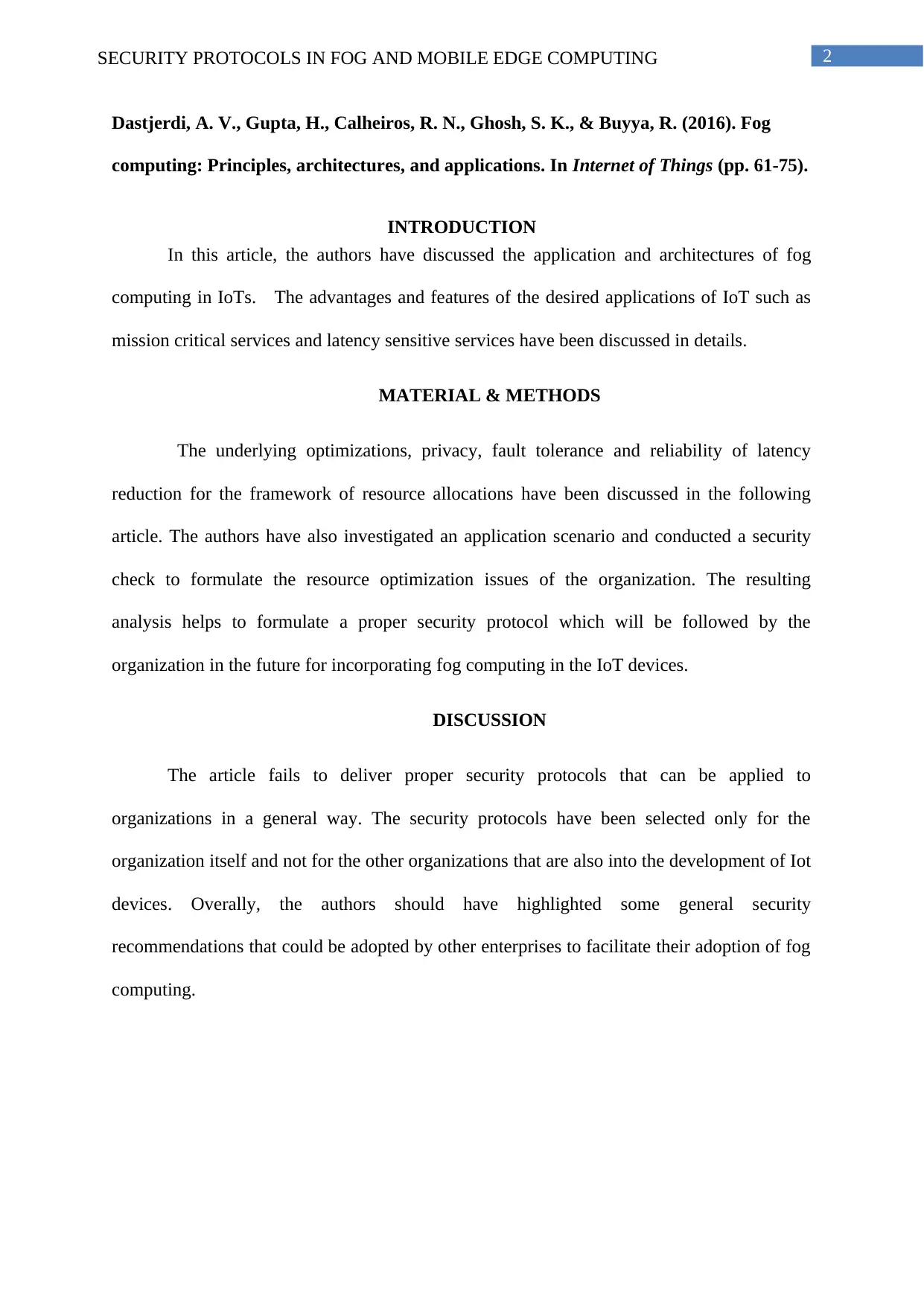
2SECURITY PROTOCOLS IN FOG AND MOBILE EDGE COMPUTING
Dastjerdi, A. V., Gupta, H., Calheiros, R. N., Ghosh, S. K., & Buyya, R. (2016). Fog
computing: Principles, architectures, and applications. In Internet of Things (pp. 61-75).
INTRODUCTION
In this article, the authors have discussed the application and architectures of fog
computing in IoTs. The advantages and features of the desired applications of IoT such as
mission critical services and latency sensitive services have been discussed in details.
MATERIAL & METHODS
The underlying optimizations, privacy, fault tolerance and reliability of latency
reduction for the framework of resource allocations have been discussed in the following
article. The authors have also investigated an application scenario and conducted a security
check to formulate the resource optimization issues of the organization. The resulting
analysis helps to formulate a proper security protocol which will be followed by the
organization in the future for incorporating fog computing in the IoT devices.
DISCUSSION
The article fails to deliver proper security protocols that can be applied to
organizations in a general way. The security protocols have been selected only for the
organization itself and not for the other organizations that are also into the development of Iot
devices. Overally, the authors should have highlighted some general security
recommendations that could be adopted by other enterprises to facilitate their adoption of fog
computing.
Dastjerdi, A. V., Gupta, H., Calheiros, R. N., Ghosh, S. K., & Buyya, R. (2016). Fog
computing: Principles, architectures, and applications. In Internet of Things (pp. 61-75).
INTRODUCTION
In this article, the authors have discussed the application and architectures of fog
computing in IoTs. The advantages and features of the desired applications of IoT such as
mission critical services and latency sensitive services have been discussed in details.
MATERIAL & METHODS
The underlying optimizations, privacy, fault tolerance and reliability of latency
reduction for the framework of resource allocations have been discussed in the following
article. The authors have also investigated an application scenario and conducted a security
check to formulate the resource optimization issues of the organization. The resulting
analysis helps to formulate a proper security protocol which will be followed by the
organization in the future for incorporating fog computing in the IoT devices.
DISCUSSION
The article fails to deliver proper security protocols that can be applied to
organizations in a general way. The security protocols have been selected only for the
organization itself and not for the other organizations that are also into the development of Iot
devices. Overally, the authors should have highlighted some general security
recommendations that could be adopted by other enterprises to facilitate their adoption of fog
computing.
⊘ This is a preview!⊘
Do you want full access?
Subscribe today to unlock all pages.

Trusted by 1+ million students worldwide

3SECURITY PROTOCOLS IN FOG AND MOBILE EDGE COMPUTING
Chiang, M., & Zhang, T. (2016). Fog and IoT: An overview of research
opportunities. IEEE Internet of Things Journal, 3(6), 854-864.
INTRODUCTION
An independent research has been conducted to understand the architecture of fog
computing. The networking, control, storage and computing systems of the architecture that
distributes the services to end users have been discussed in detail in the journal.
MATERIAL & METHODS
A wireline and mobile scenario has been taken as research subjects and how the
technology traverses across software and hardware. The journal also discusses details about
how it supports applications, IoT devices, 5g wireless networks, AI systems and the related
security measures needed to protect them from external threats. It also highlights the
challenges and opportunities of Fog in the context of IoT networking.
DISCUSSION
Although the authors have tried to explain the research opportunities of Fog in the
paper, it fails to provide appropriate recommendations for the Fog architecture. The research
methodology is not proper as well and the limitations of the research are unjustified. The
authors have stressed little on explaining the cross layer design of Fog. The author should
have highlighted the security issues first before explaining the paradigms and protocols.
Chiang, M., & Zhang, T. (2016). Fog and IoT: An overview of research
opportunities. IEEE Internet of Things Journal, 3(6), 854-864.
INTRODUCTION
An independent research has been conducted to understand the architecture of fog
computing. The networking, control, storage and computing systems of the architecture that
distributes the services to end users have been discussed in detail in the journal.
MATERIAL & METHODS
A wireline and mobile scenario has been taken as research subjects and how the
technology traverses across software and hardware. The journal also discusses details about
how it supports applications, IoT devices, 5g wireless networks, AI systems and the related
security measures needed to protect them from external threats. It also highlights the
challenges and opportunities of Fog in the context of IoT networking.
DISCUSSION
Although the authors have tried to explain the research opportunities of Fog in the
paper, it fails to provide appropriate recommendations for the Fog architecture. The research
methodology is not proper as well and the limitations of the research are unjustified. The
authors have stressed little on explaining the cross layer design of Fog. The author should
have highlighted the security issues first before explaining the paradigms and protocols.
Paraphrase This Document
Need a fresh take? Get an instant paraphrase of this document with our AI Paraphraser
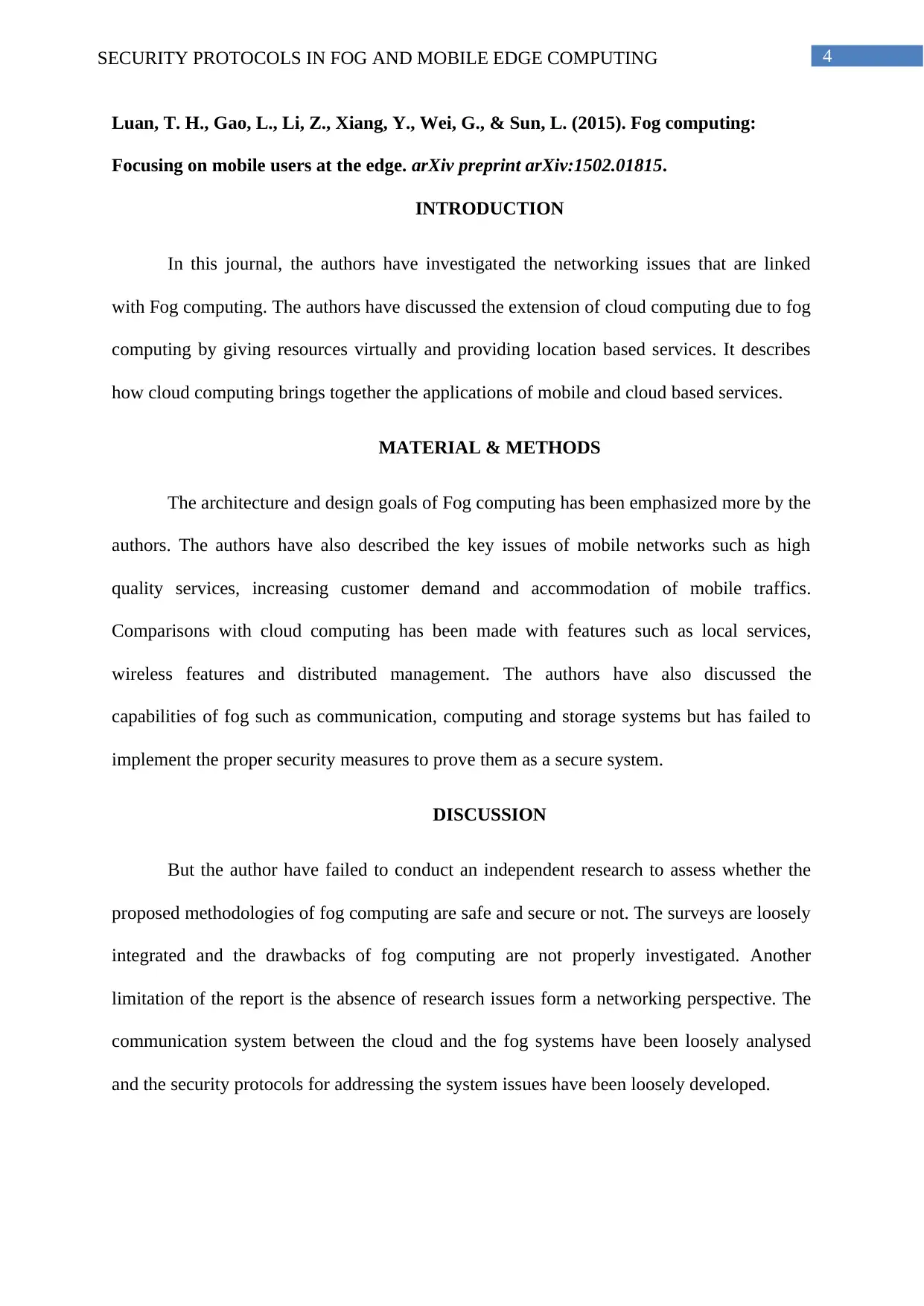
4SECURITY PROTOCOLS IN FOG AND MOBILE EDGE COMPUTING
Luan, T. H., Gao, L., Li, Z., Xiang, Y., Wei, G., & Sun, L. (2015). Fog computing:
Focusing on mobile users at the edge. arXiv preprint arXiv:1502.01815.
INTRODUCTION
In this journal, the authors have investigated the networking issues that are linked
with Fog computing. The authors have discussed the extension of cloud computing due to fog
computing by giving resources virtually and providing location based services. It describes
how cloud computing brings together the applications of mobile and cloud based services.
MATERIAL & METHODS
The architecture and design goals of Fog computing has been emphasized more by the
authors. The authors have also described the key issues of mobile networks such as high
quality services, increasing customer demand and accommodation of mobile traffics.
Comparisons with cloud computing has been made with features such as local services,
wireless features and distributed management. The authors have also discussed the
capabilities of fog such as communication, computing and storage systems but has failed to
implement the proper security measures to prove them as a secure system.
DISCUSSION
But the author have failed to conduct an independent research to assess whether the
proposed methodologies of fog computing are safe and secure or not. The surveys are loosely
integrated and the drawbacks of fog computing are not properly investigated. Another
limitation of the report is the absence of research issues form a networking perspective. The
communication system between the cloud and the fog systems have been loosely analysed
and the security protocols for addressing the system issues have been loosely developed.
Luan, T. H., Gao, L., Li, Z., Xiang, Y., Wei, G., & Sun, L. (2015). Fog computing:
Focusing on mobile users at the edge. arXiv preprint arXiv:1502.01815.
INTRODUCTION
In this journal, the authors have investigated the networking issues that are linked
with Fog computing. The authors have discussed the extension of cloud computing due to fog
computing by giving resources virtually and providing location based services. It describes
how cloud computing brings together the applications of mobile and cloud based services.
MATERIAL & METHODS
The architecture and design goals of Fog computing has been emphasized more by the
authors. The authors have also described the key issues of mobile networks such as high
quality services, increasing customer demand and accommodation of mobile traffics.
Comparisons with cloud computing has been made with features such as local services,
wireless features and distributed management. The authors have also discussed the
capabilities of fog such as communication, computing and storage systems but has failed to
implement the proper security measures to prove them as a secure system.
DISCUSSION
But the author have failed to conduct an independent research to assess whether the
proposed methodologies of fog computing are safe and secure or not. The surveys are loosely
integrated and the drawbacks of fog computing are not properly investigated. Another
limitation of the report is the absence of research issues form a networking perspective. The
communication system between the cloud and the fog systems have been loosely analysed
and the security protocols for addressing the system issues have been loosely developed.
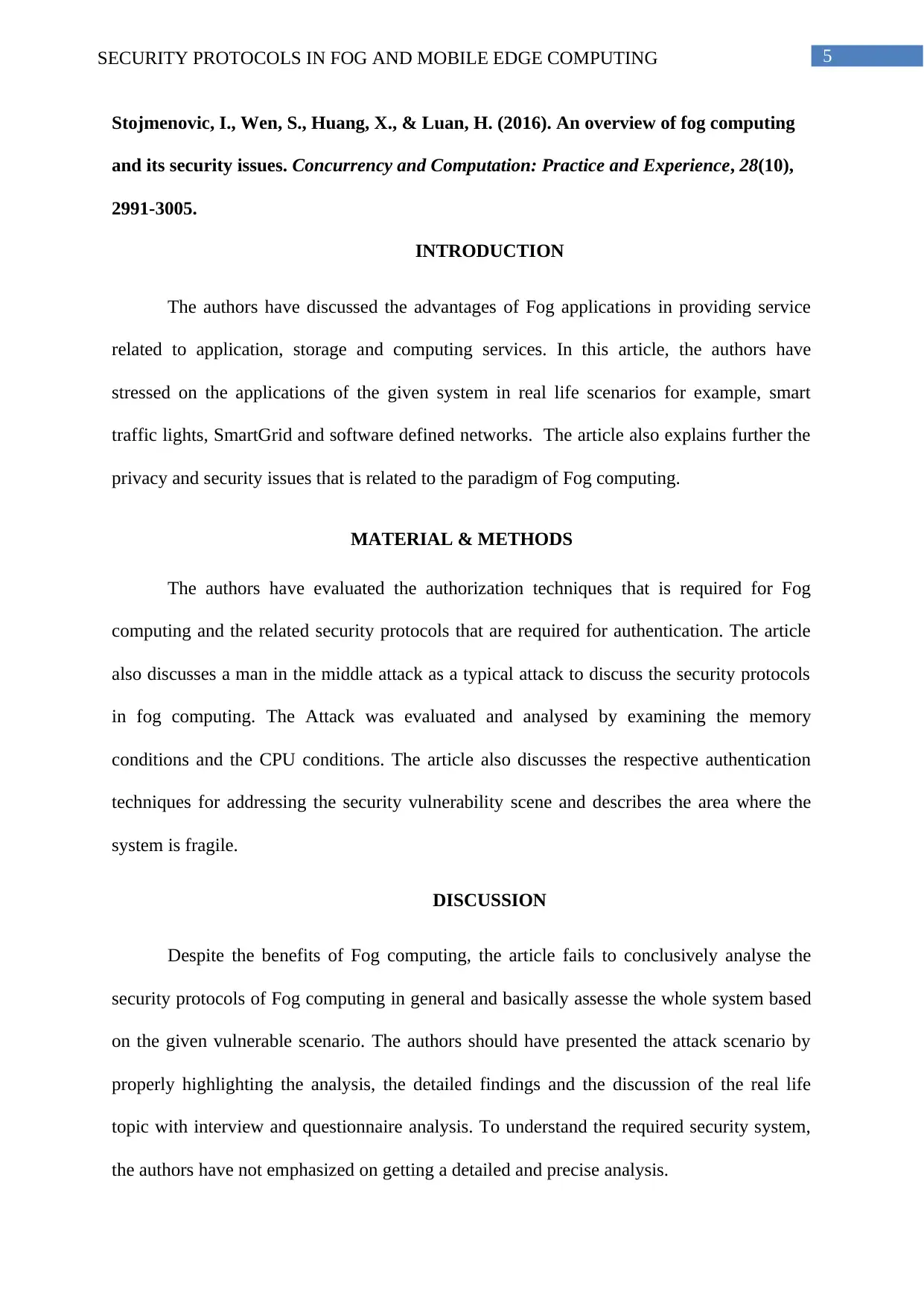
5SECURITY PROTOCOLS IN FOG AND MOBILE EDGE COMPUTING
Stojmenovic, I., Wen, S., Huang, X., & Luan, H. (2016). An overview of fog computing
and its security issues. Concurrency and Computation: Practice and Experience, 28(10),
2991-3005.
INTRODUCTION
The authors have discussed the advantages of Fog applications in providing service
related to application, storage and computing services. In this article, the authors have
stressed on the applications of the given system in real life scenarios for example, smart
traffic lights, SmartGrid and software defined networks. The article also explains further the
privacy and security issues that is related to the paradigm of Fog computing.
MATERIAL & METHODS
The authors have evaluated the authorization techniques that is required for Fog
computing and the related security protocols that are required for authentication. The article
also discusses a man in the middle attack as a typical attack to discuss the security protocols
in fog computing. The Attack was evaluated and analysed by examining the memory
conditions and the CPU conditions. The article also discusses the respective authentication
techniques for addressing the security vulnerability scene and describes the area where the
system is fragile.
DISCUSSION
Despite the benefits of Fog computing, the article fails to conclusively analyse the
security protocols of Fog computing in general and basically assesse the whole system based
on the given vulnerable scenario. The authors should have presented the attack scenario by
properly highlighting the analysis, the detailed findings and the discussion of the real life
topic with interview and questionnaire analysis. To understand the required security system,
the authors have not emphasized on getting a detailed and precise analysis.
Stojmenovic, I., Wen, S., Huang, X., & Luan, H. (2016). An overview of fog computing
and its security issues. Concurrency and Computation: Practice and Experience, 28(10),
2991-3005.
INTRODUCTION
The authors have discussed the advantages of Fog applications in providing service
related to application, storage and computing services. In this article, the authors have
stressed on the applications of the given system in real life scenarios for example, smart
traffic lights, SmartGrid and software defined networks. The article also explains further the
privacy and security issues that is related to the paradigm of Fog computing.
MATERIAL & METHODS
The authors have evaluated the authorization techniques that is required for Fog
computing and the related security protocols that are required for authentication. The article
also discusses a man in the middle attack as a typical attack to discuss the security protocols
in fog computing. The Attack was evaluated and analysed by examining the memory
conditions and the CPU conditions. The article also discusses the respective authentication
techniques for addressing the security vulnerability scene and describes the area where the
system is fragile.
DISCUSSION
Despite the benefits of Fog computing, the article fails to conclusively analyse the
security protocols of Fog computing in general and basically assesse the whole system based
on the given vulnerable scenario. The authors should have presented the attack scenario by
properly highlighting the analysis, the detailed findings and the discussion of the real life
topic with interview and questionnaire analysis. To understand the required security system,
the authors have not emphasized on getting a detailed and precise analysis.
⊘ This is a preview!⊘
Do you want full access?
Subscribe today to unlock all pages.

Trusted by 1+ million students worldwide

6SECURITY PROTOCOLS IN FOG AND MOBILE EDGE COMPUTING
Yi, S., Qin, Z., & Li, Q. (2015, August). Security and privacy issues of fog computing: A
survey. In International Conference on Wireless Algorithms, Systems, and
Applications (pp. 685-695). Springer, Cham.
INTRODUCTION
In this article, a survey has been conducted by the authors to understand Fog
computing that enhances the features of Cloud computing to the network edges. The authors
have discussed the similarities of cloud computing with fog computing and has discussed the
privacy and security challenges that Fog computing faces.
MATERIAL & METHODS
In the paper, a survey has been conducted to understand the solutions and challenges
that Fog computing faces in a brief manner. Deployment models and service delivery models
of Fog computing has been discussed in detail. Security issues related to authentication
techniques, trust models and infected fog node has been discussed in detail in the article.
Other issues such as network security secure computation and secure data storage has been
discussed by the authors in detail.
DISCUSSION
The survey fails to properly state the recommended security protocols for addressing
the defined security and privacy issues that are mentioned in the paper. The authors have also
failed to analyse the security threats through a recent survey analysis and the entire survey
has been taken to address the security issues of Fog computing in a general way. Another
limitation of the study is enabling proper methodologies to analyse the survey. The paper
does not contain any methodologies about how the survey was carried out and how the
security and privacy issues were discovered.
Yi, S., Qin, Z., & Li, Q. (2015, August). Security and privacy issues of fog computing: A
survey. In International Conference on Wireless Algorithms, Systems, and
Applications (pp. 685-695). Springer, Cham.
INTRODUCTION
In this article, a survey has been conducted by the authors to understand Fog
computing that enhances the features of Cloud computing to the network edges. The authors
have discussed the similarities of cloud computing with fog computing and has discussed the
privacy and security challenges that Fog computing faces.
MATERIAL & METHODS
In the paper, a survey has been conducted to understand the solutions and challenges
that Fog computing faces in a brief manner. Deployment models and service delivery models
of Fog computing has been discussed in detail. Security issues related to authentication
techniques, trust models and infected fog node has been discussed in detail in the article.
Other issues such as network security secure computation and secure data storage has been
discussed by the authors in detail.
DISCUSSION
The survey fails to properly state the recommended security protocols for addressing
the defined security and privacy issues that are mentioned in the paper. The authors have also
failed to analyse the security threats through a recent survey analysis and the entire survey
has been taken to address the security issues of Fog computing in a general way. Another
limitation of the study is enabling proper methodologies to analyse the survey. The paper
does not contain any methodologies about how the survey was carried out and how the
security and privacy issues were discovered.
Paraphrase This Document
Need a fresh take? Get an instant paraphrase of this document with our AI Paraphraser

7SECURITY PROTOCOLS IN FOG AND MOBILE EDGE COMPUTING
Yi, S., Hao, Z., Qin, Z., & Li, Q. (2015, November). Fog computing: Platform and
applications. In Hot Topics in Web Systems and Technologies (HotWeb), 2015 Third
IEEE Workshop on (pp. 73-78). IEEE.
INTRODUCTION
The research paper describes the inherent problems of Cloud computing and evaluates
the advantages that Fog computing can provide to mitigate those inherent issues. In cloud
computing, the issues with location awareness, absence of mobility support and unacceptable
latency pose a huge problem for the services and applications that cannot benefit from this
computing paradigm. The authors have emphasized on the rise of fog computing to address
these issues and provide the applications with a promising infrastructure.
MATERIAL & METHODS
The authors have explored the comprehensive definition of fog computing and has
discussed similar concepts about it. The goals and challenges of Fog computing have been
widely debated in the research paper and a platform design has been created for exemplar
applications. The authors have also designed a prototype for the Fog computing system and
has mentioned in detail the security protocols that are necessary for implementing the
platform in a secure way.
DISCUSSION
The research paper does have some inherent limitations. First of all, the prototype
does not have a proper implementation strategy. The authors have failed to mention which
industries are tolerable for integrating the designed systems and what setbacks they might
face during the implementation process. The paper also fails to demonstrate the negative
Yi, S., Hao, Z., Qin, Z., & Li, Q. (2015, November). Fog computing: Platform and
applications. In Hot Topics in Web Systems and Technologies (HotWeb), 2015 Third
IEEE Workshop on (pp. 73-78). IEEE.
INTRODUCTION
The research paper describes the inherent problems of Cloud computing and evaluates
the advantages that Fog computing can provide to mitigate those inherent issues. In cloud
computing, the issues with location awareness, absence of mobility support and unacceptable
latency pose a huge problem for the services and applications that cannot benefit from this
computing paradigm. The authors have emphasized on the rise of fog computing to address
these issues and provide the applications with a promising infrastructure.
MATERIAL & METHODS
The authors have explored the comprehensive definition of fog computing and has
discussed similar concepts about it. The goals and challenges of Fog computing have been
widely debated in the research paper and a platform design has been created for exemplar
applications. The authors have also designed a prototype for the Fog computing system and
has mentioned in detail the security protocols that are necessary for implementing the
platform in a secure way.
DISCUSSION
The research paper does have some inherent limitations. First of all, the prototype
does not have a proper implementation strategy. The authors have failed to mention which
industries are tolerable for integrating the designed systems and what setbacks they might
face during the implementation process. The paper also fails to demonstrate the negative
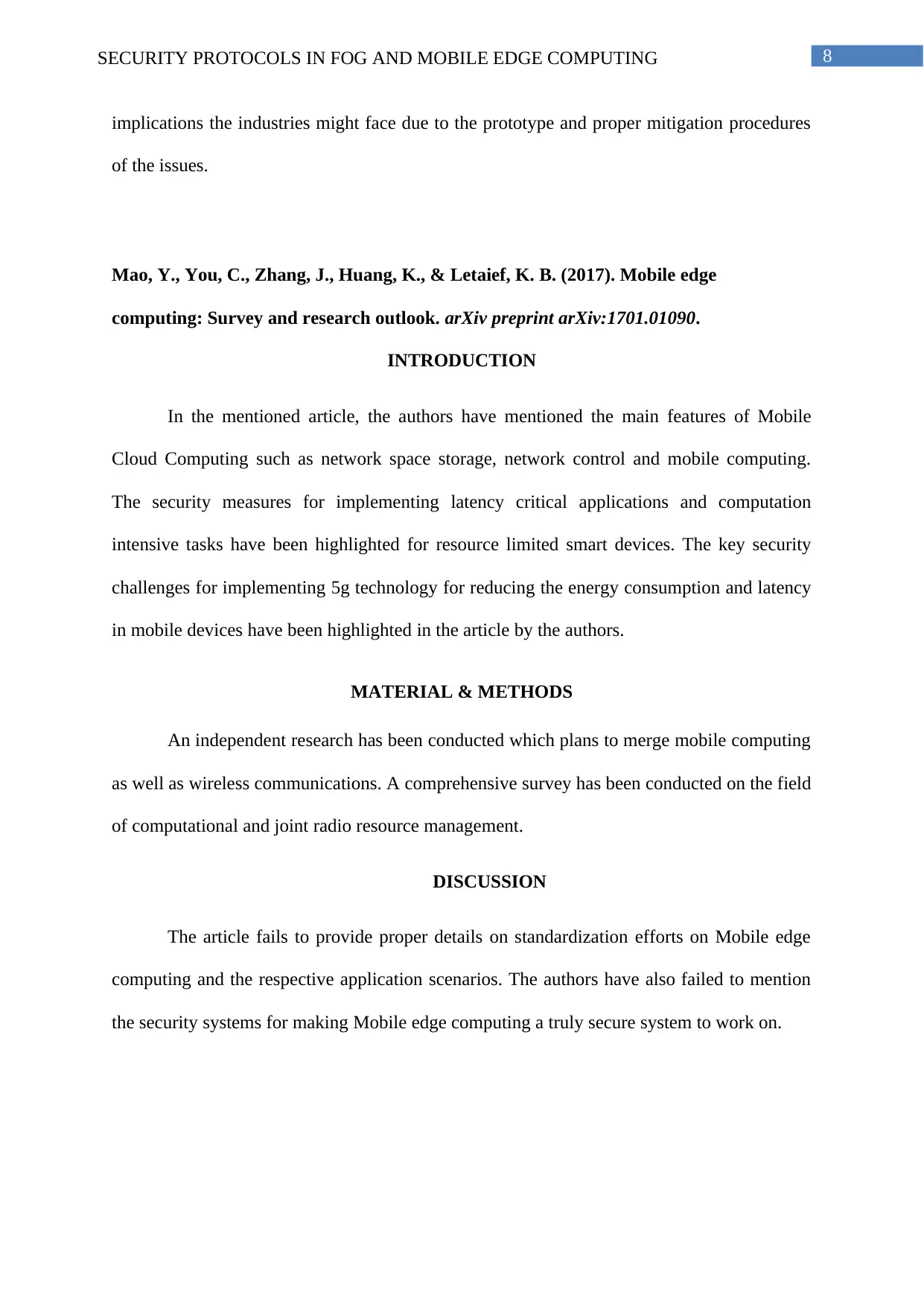
8SECURITY PROTOCOLS IN FOG AND MOBILE EDGE COMPUTING
implications the industries might face due to the prototype and proper mitigation procedures
of the issues.
Mao, Y., You, C., Zhang, J., Huang, K., & Letaief, K. B. (2017). Mobile edge
computing: Survey and research outlook. arXiv preprint arXiv:1701.01090.
INTRODUCTION
In the mentioned article, the authors have mentioned the main features of Mobile
Cloud Computing such as network space storage, network control and mobile computing.
The security measures for implementing latency critical applications and computation
intensive tasks have been highlighted for resource limited smart devices. The key security
challenges for implementing 5g technology for reducing the energy consumption and latency
in mobile devices have been highlighted in the article by the authors.
MATERIAL & METHODS
An independent research has been conducted which plans to merge mobile computing
as well as wireless communications. A comprehensive survey has been conducted on the field
of computational and joint radio resource management.
DISCUSSION
The article fails to provide proper details on standardization efforts on Mobile edge
computing and the respective application scenarios. The authors have also failed to mention
the security systems for making Mobile edge computing a truly secure system to work on.
implications the industries might face due to the prototype and proper mitigation procedures
of the issues.
Mao, Y., You, C., Zhang, J., Huang, K., & Letaief, K. B. (2017). Mobile edge
computing: Survey and research outlook. arXiv preprint arXiv:1701.01090.
INTRODUCTION
In the mentioned article, the authors have mentioned the main features of Mobile
Cloud Computing such as network space storage, network control and mobile computing.
The security measures for implementing latency critical applications and computation
intensive tasks have been highlighted for resource limited smart devices. The key security
challenges for implementing 5g technology for reducing the energy consumption and latency
in mobile devices have been highlighted in the article by the authors.
MATERIAL & METHODS
An independent research has been conducted which plans to merge mobile computing
as well as wireless communications. A comprehensive survey has been conducted on the field
of computational and joint radio resource management.
DISCUSSION
The article fails to provide proper details on standardization efforts on Mobile edge
computing and the respective application scenarios. The authors have also failed to mention
the security systems for making Mobile edge computing a truly secure system to work on.
⊘ This is a preview!⊘
Do you want full access?
Subscribe today to unlock all pages.

Trusted by 1+ million students worldwide
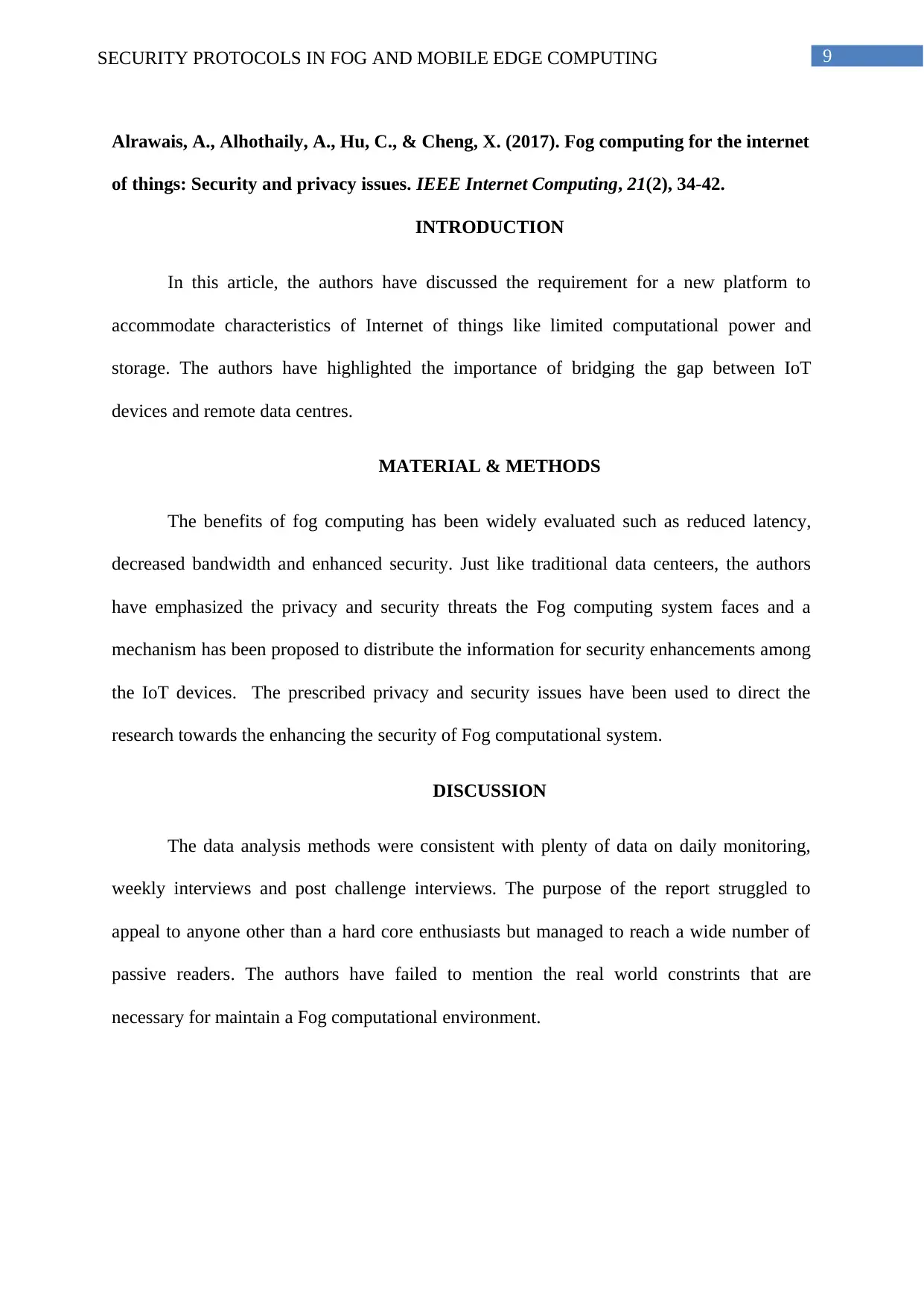
9SECURITY PROTOCOLS IN FOG AND MOBILE EDGE COMPUTING
Alrawais, A., Alhothaily, A., Hu, C., & Cheng, X. (2017). Fog computing for the internet
of things: Security and privacy issues. IEEE Internet Computing, 21(2), 34-42.
INTRODUCTION
In this article, the authors have discussed the requirement for a new platform to
accommodate characteristics of Internet of things like limited computational power and
storage. The authors have highlighted the importance of bridging the gap between IoT
devices and remote data centres.
MATERIAL & METHODS
The benefits of fog computing has been widely evaluated such as reduced latency,
decreased bandwidth and enhanced security. Just like traditional data centeers, the authors
have emphasized the privacy and security threats the Fog computing system faces and a
mechanism has been proposed to distribute the information for security enhancements among
the IoT devices. The prescribed privacy and security issues have been used to direct the
research towards the enhancing the security of Fog computational system.
DISCUSSION
The data analysis methods were consistent with plenty of data on daily monitoring,
weekly interviews and post challenge interviews. The purpose of the report struggled to
appeal to anyone other than a hard core enthusiasts but managed to reach a wide number of
passive readers. The authors have failed to mention the real world constrints that are
necessary for maintain a Fog computational environment.
Alrawais, A., Alhothaily, A., Hu, C., & Cheng, X. (2017). Fog computing for the internet
of things: Security and privacy issues. IEEE Internet Computing, 21(2), 34-42.
INTRODUCTION
In this article, the authors have discussed the requirement for a new platform to
accommodate characteristics of Internet of things like limited computational power and
storage. The authors have highlighted the importance of bridging the gap between IoT
devices and remote data centres.
MATERIAL & METHODS
The benefits of fog computing has been widely evaluated such as reduced latency,
decreased bandwidth and enhanced security. Just like traditional data centeers, the authors
have emphasized the privacy and security threats the Fog computing system faces and a
mechanism has been proposed to distribute the information for security enhancements among
the IoT devices. The prescribed privacy and security issues have been used to direct the
research towards the enhancing the security of Fog computational system.
DISCUSSION
The data analysis methods were consistent with plenty of data on daily monitoring,
weekly interviews and post challenge interviews. The purpose of the report struggled to
appeal to anyone other than a hard core enthusiasts but managed to reach a wide number of
passive readers. The authors have failed to mention the real world constrints that are
necessary for maintain a Fog computational environment.
Paraphrase This Document
Need a fresh take? Get an instant paraphrase of this document with our AI Paraphraser
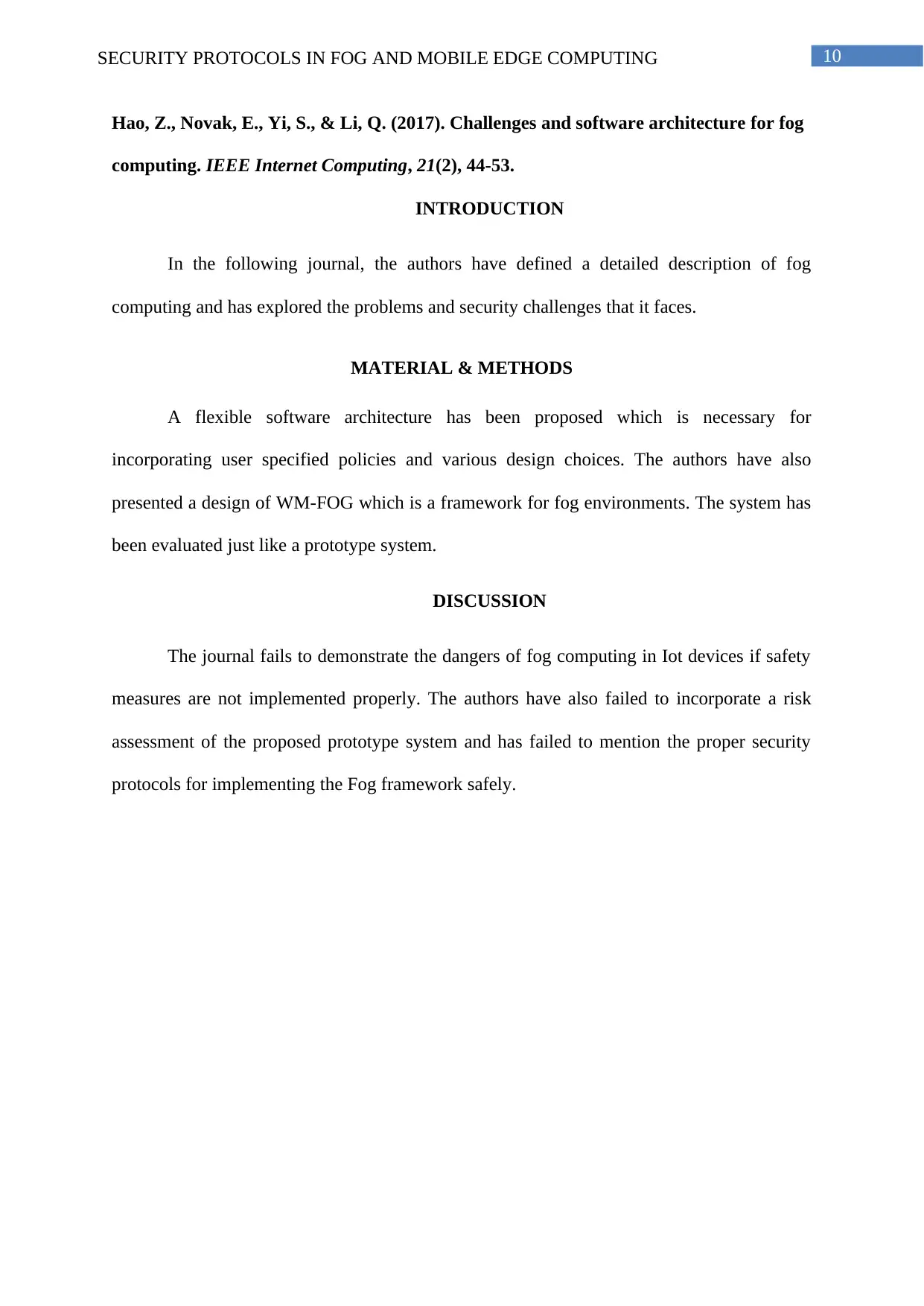
10SECURITY PROTOCOLS IN FOG AND MOBILE EDGE COMPUTING
Hao, Z., Novak, E., Yi, S., & Li, Q. (2017). Challenges and software architecture for fog
computing. IEEE Internet Computing, 21(2), 44-53.
INTRODUCTION
In the following journal, the authors have defined a detailed description of fog
computing and has explored the problems and security challenges that it faces.
MATERIAL & METHODS
A flexible software architecture has been proposed which is necessary for
incorporating user specified policies and various design choices. The authors have also
presented a design of WM-FOG which is a framework for fog environments. The system has
been evaluated just like a prototype system.
DISCUSSION
The journal fails to demonstrate the dangers of fog computing in Iot devices if safety
measures are not implemented properly. The authors have also failed to incorporate a risk
assessment of the proposed prototype system and has failed to mention the proper security
protocols for implementing the Fog framework safely.
Hao, Z., Novak, E., Yi, S., & Li, Q. (2017). Challenges and software architecture for fog
computing. IEEE Internet Computing, 21(2), 44-53.
INTRODUCTION
In the following journal, the authors have defined a detailed description of fog
computing and has explored the problems and security challenges that it faces.
MATERIAL & METHODS
A flexible software architecture has been proposed which is necessary for
incorporating user specified policies and various design choices. The authors have also
presented a design of WM-FOG which is a framework for fog environments. The system has
been evaluated just like a prototype system.
DISCUSSION
The journal fails to demonstrate the dangers of fog computing in Iot devices if safety
measures are not implemented properly. The authors have also failed to incorporate a risk
assessment of the proposed prototype system and has failed to mention the proper security
protocols for implementing the Fog framework safely.
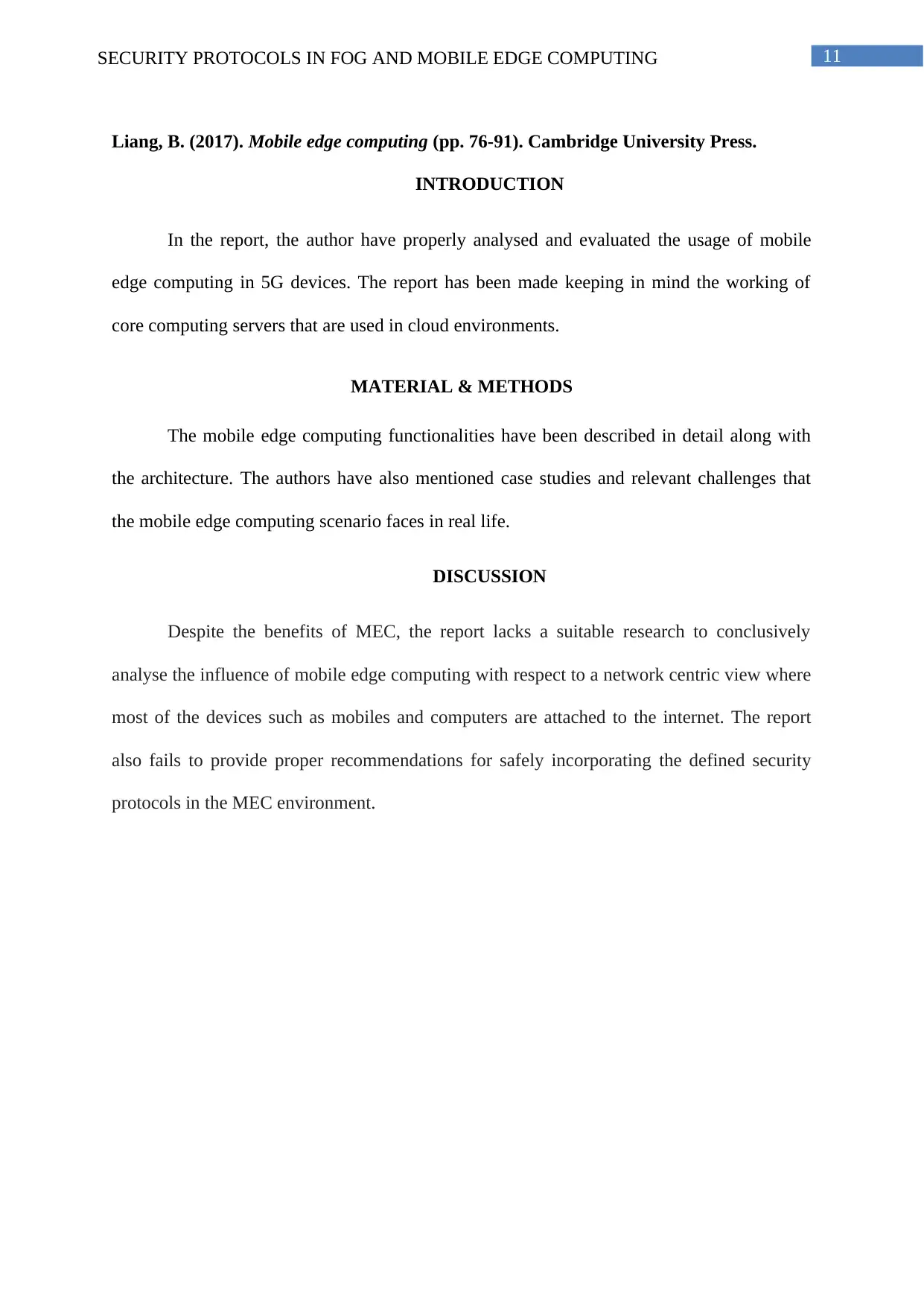
11SECURITY PROTOCOLS IN FOG AND MOBILE EDGE COMPUTING
Liang, B. (2017). Mobile edge computing (pp. 76-91). Cambridge University Press.
INTRODUCTION
In the report, the author have properly analysed and evaluated the usage of mobile
edge computing in 5G devices. The report has been made keeping in mind the working of
core computing servers that are used in cloud environments.
MATERIAL & METHODS
The mobile edge computing functionalities have been described in detail along with
the architecture. The authors have also mentioned case studies and relevant challenges that
the mobile edge computing scenario faces in real life.
DISCUSSION
Despite the benefits of MEC, the report lacks a suitable research to conclusively
analyse the influence of mobile edge computing with respect to a network centric view where
most of the devices such as mobiles and computers are attached to the internet. The report
also fails to provide proper recommendations for safely incorporating the defined security
protocols in the MEC environment.
Liang, B. (2017). Mobile edge computing (pp. 76-91). Cambridge University Press.
INTRODUCTION
In the report, the author have properly analysed and evaluated the usage of mobile
edge computing in 5G devices. The report has been made keeping in mind the working of
core computing servers that are used in cloud environments.
MATERIAL & METHODS
The mobile edge computing functionalities have been described in detail along with
the architecture. The authors have also mentioned case studies and relevant challenges that
the mobile edge computing scenario faces in real life.
DISCUSSION
Despite the benefits of MEC, the report lacks a suitable research to conclusively
analyse the influence of mobile edge computing with respect to a network centric view where
most of the devices such as mobiles and computers are attached to the internet. The report
also fails to provide proper recommendations for safely incorporating the defined security
protocols in the MEC environment.
⊘ This is a preview!⊘
Do you want full access?
Subscribe today to unlock all pages.

Trusted by 1+ million students worldwide
1 out of 15
Related Documents
Your All-in-One AI-Powered Toolkit for Academic Success.
+13062052269
info@desklib.com
Available 24*7 on WhatsApp / Email
![[object Object]](/_next/static/media/star-bottom.7253800d.svg)
Unlock your academic potential
Copyright © 2020–2025 A2Z Services. All Rights Reserved. Developed and managed by ZUCOL.





